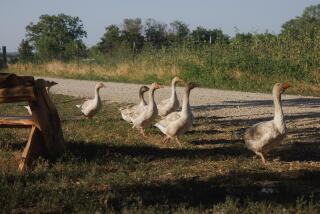Erosion Is Central Concern : USDA Is Looking Into Rules for ‘Sodbusting’
- Share via
WASHINGTON — Farmers converted 11.1 million acres to planting between 1979 and 1981--an area larger than Connecticut, Delaware, New Jersey and Rhode Island combined.
The Agriculture Department says, however, that the turning of land to crops--generally called “sodbusting”--has not been done on a large scale. The 11.1 million acres, for example, represented less than 3% of U.S. cropland in 1982.
Further, according to a new USDA study, land switched from non-crop uses to growing does not necessarily result in significantly greater erosion problems.
But many conservationists and like-minded members of Congress are concerned about the use of fragile land to produce crops, particularly commodities that are supported by government price programs, such as corn, wheat and cotton.
Attempts have been made in Congress to crack down on the sodbusting by denying farmers at least some federal subsidies and other benefits if they plant land that is highly susceptible to erosion. The Reagan Administration’s farm bill includes one version, and most other bills also carry sodbuster provisions.
The Agriculture Department’s Economic Research Service takes a look at sodbusting in a new report and concludes that more precise information is necessary before new federal restrictions can properly be enforced.
Also, the report said, the boom era of the late 1970s--of rising exports and land values--is “not likely to recur in the immediate future” because of the depressed farm economy.
“Nevertheless, prohibiting farm program subsidies on highly erodible cropland recently converted from other uses would remove potentially large incentives to bring such land into production,” the report said.
“Removing eligibility for farm program subsidies on such land would ensure greater consistency between USDA commodity and conservation objectives. For such a restriction to be effective, however, more precise identification of highly erodible lands than that provided by current proposals would be required.”
Term Applied Loosely
Although the term “sodbusting” conveys the notion of plowing up virgin grasslands, the bills in Congress generally apply to any land converted to crop production in recent years.
Between 1975 and 1977, the report said, the greatest concentration of sodbusting occurred in the northern Great Plains, Appalachian and Rocky Mountain regions, and accounted for more than 40% of the land conversion. The Corn Belt reported only 9.9%; the Southern plains 9.7%.
The actual land area switched to crops was about 9.1-million acres during the 1975-77 period.
Between 1979 and 1981, when sodbusting nationally affected 11.1 million acres, declines were reported in most regions except the Corn Belt, which accounted for 19.6% of the total, and the Southern plains, which accounted for 10.6%.
Highly Erosive Land Used
“A principal public concern with sodbusting is the belief that the land being converted to cropland contributes more to erosion than the existing cropland base,” the report said. “Since the crops grown on the newly converted land are highly erosive compared with pasture, range and forest uses, increased erosion undoubtedly results from land conversion. The real issue is whether new cropland is more erodible than the existing cropland base.”
The report said that the average erosion rate of new cropland was 8.1 tons an acre per year, only slightly more than the 7.4 tons recorded for all cropland.
“Stated another way, the new cropland made up 2.6% of all cropland and accounted for 2.9% of total erosion from cropland in 1982,” the report said. “It does not appear from this evidence that all newly converted cropland has more erosion than existing cropland.”
Most of the new cropland had no wind erosion problem, and only about one-fourth had water erosion rates exceeding acceptable limits, the report said. Wind erosion was actually lower than that of older fields, although water erosion was slightly higher.
11.1 Million Acres
About 2.35 million acres, or 21% of the new cropland were rated “highly erodible” under present classifications.
The report also said that of the 11.1 million acres switched to crops between 1979 and 1981, only 7.4 million acres were used to grow the major commodities covered by federal programs. Between 2.1 million and 2.3 million acres were highly erodible, depending on the definition used.
But only 1.9 million of the acres converted in 1982 were both highly erodible and used to grow crops covered by federal programs--thus, those crops would be ineligible for benefits under proposed legislation.
“Although actual (federal) program participation on newly converted cropland is not known, farm programs would have provided an average subsidy of nearly $17 per acre for conversion of highly erodible land to cropland,” the report said.
More to Read
Sign up for Essential California
The most important California stories and recommendations in your inbox every morning.
You may occasionally receive promotional content from the Los Angeles Times.










